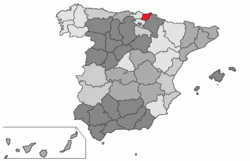Guipúscoa
Guipúscoa | |
|---|---|
 | |
Comunidade autónoma | Comunidade Autónoma Basca |
Capital | São Sebastião(Donostia) |
Área | 1.909 km² |
População: | 691.895 (2006) |
Fronteiras: | Biscaia, Álava, Navarra, Álava, França e Baía da Biscaia |
Províncias da Espanha | |
Guipúscoa[1] (na forma oficial basca Gipuzkoa[2] (2011) ou Guipúzcoa em castelhano ) é uma província do País Basco, localizada no Norte da Espanha. Faz fronteira com as províncias de Biscaia e Álava, com a Comunidade Foral de Navarra, com a França e com a Baía de Biscaia.
Tem uma superfície de 1.980 quilômetros quadrados, sendo a menor província continental espanhola. Sua população é de 682.977 habitantes (2002), dos quais cerca de 25% vivem na capital, São Sebastião (Donostia-San Sebastián). Outras importantes cidades são Irun, Errenteria, Zarautz, Arrasate/Mondragón, Eibar, Bidegoian e Tolosa.
Referências
↑ Fernandes, Ivo Xavier (1941). Topónimos e Gentílicos. I. Porto: Editora Educação Nacional, Lda.
↑ (em castelhano) Ley 19/2011, de 5 de julio, por la que pasan a denominarse oficialmente "Araba/Álava", "Gipuzkoa" y "Bizkaia" las demarcaciones provinciales llamadas anteriormente "Álava", "Guipúzcoa" y "Vizcaya".
Ligações externas |
- Página oficial da província